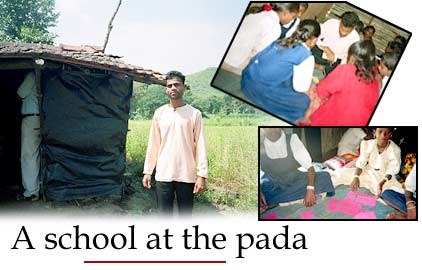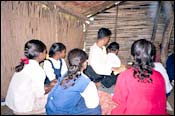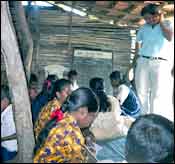
The setting is picturesque. Right after the monsoon, the hills are awash in green, the farms overflowing with crops... Nature is at her bountiful best. Vedhegaon is a small village near the Vajreshwari temple, barely 70 kilometres from Mumbai city, and not very far from its sprawling suburbs.
In the villages and padas (hamlets) nestling among the farms and hills that form the northern fringes of the Western Ghats, a novel experiment is under way to rid India of one of its greatest evils: illiteracy. The new methods to wipe out illiteracy, especially among the Adivasi tribal children are laudable and have met with sufficient success to earn funding from the United Nations Development Programme and the government of Maharashtra, besides other international aid organisations.
It is not that government-run schools don't exist, but, as is the wont, these schools are located in the centre of the villages. And, in the caste-ridden villages, this has a telling impact on the tribal children: the distance they have to travel to reach the school becomes a hindrance.
In the heart of the villages reside the upper castes and the dominant Marathas and the Kunbis, the main farming communities. Slightly beyond the villages reside the lower castes. The Dalits, the scheduled castes, live outside the main village. The Adivasis live even further away, in small padas that are often at a distance of more than a kilometre or two from the villages and the government-run schools.
 Noticing this lacuna, the Vidhayak Sansad, a non-government organisation working to eradicate child labour and promote literacy, set up mukta shalas (free schools) in the Adivasi padas. Earlier, the Vidhayak Sansad, which was started in 1979, undertook a survey of 300 (mostly Adivasi) padas in three talukas (sub-districts) -- Vasai, Bhiwandi, Shahpur -- in Thane district, north of Mumbai. And found that 12,000 children were not going to school!
Noticing this lacuna, the Vidhayak Sansad, a non-government organisation working to eradicate child labour and promote literacy, set up mukta shalas (free schools) in the Adivasi padas. Earlier, the Vidhayak Sansad, which was started in 1979, undertook a survey of 300 (mostly Adivasi) padas in three talukas (sub-districts) -- Vasai, Bhiwandi, Shahpur -- in Thane district, north of Mumbai. And found that 12,000 children were not going to school!
"The reasons are linked to poverty," says Vidyulata Pandit, director, Vidhayak Sansad. "The children work as balgi [who look after smaller children -- either their siblings or those of the local landlords -- while their parents work] or are employed to graze goats or cattle. Often the parents migrate in search of jobs and the small children, who are left behind with the grandparents, find it difficult to travel to the schools which are quite far from their homes."
Also read: Back to School: The experiment in Magadi, Karnataka
Transport facilities are negligible; roads are few and far between in the villages, thus making distances greater.
The Vidhyak Sansad set up mukta shalas wherever it found 15 children in need of education between class 1 and class 4. Today, they run 60 such shalas like the Vedhegaon Mukta Shala The Adivasi pada consists of a few mud huts surrounded by rice fields. The centre of Vedhegaon village, where the government-run school is located, is a few kilometres away. In a telling comment on India's social and economic structure, no Adivasi owns any of the rice fields next to their huts: they are all owned by the farmers who are invariably Maratha or Kunbi or other such upper castes.
The Vedhegaon Mukta Shala is a single hut with a small door. The hut is 'wrapped' in a black coloured plastic sheet that was put up the previous night to keep out the rain. One has to bend to enter through the low door. Inside, 20 children of different ages huddle together.
The room is stifling hot, because the plastic sheet blocks out the wind. The teacher says though the sheet will be removed now that the monsoon is technically over, thus allowing some much-needed breeze to waft through the 'classroom,' it remains very hot inside.
 Outside the hut, the sun is bright enough to hurt the eye; inside, it is quite dark (thought not pitch black) since light enters through the door and from the gap between the thatched roof and the mud walls. The children, in tattered uniforms or clothes, are sitting on the floor, reading their Marathi textbooks.
Outside the hut, the sun is bright enough to hurt the eye; inside, it is quite dark (thought not pitch black) since light enters through the door and from the gap between the thatched roof and the mud walls. The children, in tattered uniforms or clothes, are sitting on the floor, reading their Marathi textbooks.
Despite the discomfort, they look happy and eager. Their teacher, 22-year-old Kiran Vaman Andhere, is teaching them mathematics. Soon, he separates the children into small groups of about five each and teaches them as per what their class level would have been. The older kids work at their multiplication tables. The younger ones are learning four digit numbers. The smallest ones are just learning their first numbers. All of them use learning kits.
So what makes the mukta shalas different from other such schools? "Here, there is no compulsion to attend," says with Anand Pawar of the Vidhayak Sansad. "The students are allowed to attend whenever they can."
The schools also provide a midday meal, thus giving students another incentive to be regular.
Also read: Studying their way out of crime
Often, the students in the mukta shalas are overage. In regular schools, this can be a source of embarrassment. "Often Adivasi students don't attend regular schools because they are much older then the other students," says Pawar. In the mukta shalas, while the students are taught as per the government prescribed syllabus, the teaching style is flexible keeping in mind the students' unique difficulties.
What about funding? "The United Nations Development Fund has provided funding for the mukta shalas for three years from 2001 to 2004. After that, the Maharashtra government will take them over and make them vasti shalas [vasti means locality]," said Pawar.
"The aim of the mukta shalas is to equip the students sufficiently so that they can go to the local school," said Dushyant Dhaivat, who works for the Shramjivi Sanghatana, a sister organisation of the Vidhayak Sansad.
Part II: Schools with a difference!
Photographs: Amberish K Diwanji
Image: Rahil Shaikh





